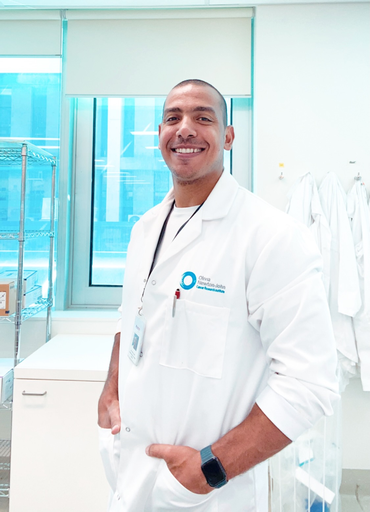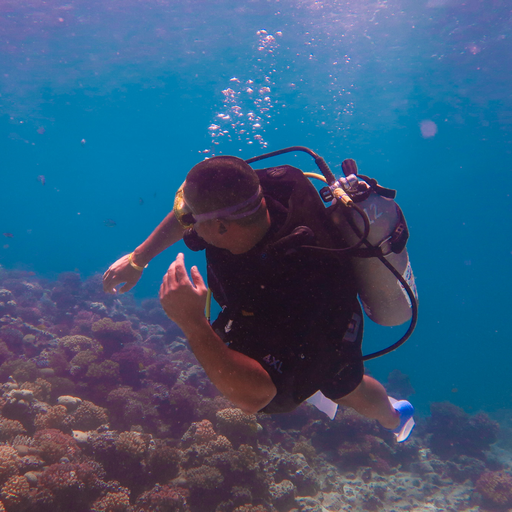Opportunity is a master of disguise
It presents in ways we often overlook, and it sometimes requires bold steps, imagination, bravery and very hard work. And it also requires being alert.
In October 2021, Associate Professor David Williams, a Clinician Scientist and Anatomical Pathologist at Austin Health, expressed to Amr an interest in establishing a collaboration to better profile colon cancer patients. Amr remembers that this marked the beginning of an exciting project as a collaboration between the Olivia Newton-John Cancer Research Institute and the La Trobe University.
Despite the fact that both he and David were deeply embedded in their respective work and grant applications preparation, but nonetheless saw the opportunity to benefit cancer patients. They started structuring what has become this exciting project to conduct the type of preliminary observation that would ultimately allow them to find major research support for their project.
Amr’s life has been about creating the right environment for opportunity. Coming from a family whose father and brothers were all involved in various areas of medicine, Amr’s early studies in Egypt were in veterinary medicine. However, he became interested in molecular microbiology and decided to pursue a master’s degree in Scotland, that led to a PhD in cancer research in Australia, and as an international and migrating student he had to work hard to build a portfolio that would give him opportunities for key roles.
In describing this period of his life, Amr told us that he loved working in medical research in particular when he was given opportunities to work on blood cancer and colon cancer. Getting his name on a couple of big papers helped him apply for roles in the UK, Switzerland and Sweden. But eventually he chose an opportunity in Australia with Prof Sarah Russell as his mentor and conducted his PhD studies on the development of T-cells and to better understand the various stages of immune cells as they mature.
The opportunity
Amr’s research passion stems from his desire to translate his work from the lab to the clinic. In line with that, he has actively established collaborations with other researchers with expertise in technologies that could help achieve an immediate translational impact. That’s when a second opportunity arose—the news of Prof. Brian Abbey’s innovative imaging technology, the NanoMslide®, caught Amr’s attention. He reached out to Brian to establish a collaboration that would incorporate this novel technology into the project.
Amr’s previous experience working in different areas of medical science throughout the world had set him up with the knowledge of different concepts including various aspects of imaging cells and biological processes. Knowledge that would create a strong foundation for this project. Expressing his interest to David in Tumour-infiltrating lymphocytes (TILs), the immune cells that can recognise and destroy cancer cells. Amr reasoned that the structure of their main component, collagen, might help to better understand how colon cancer develops and ultimately to help determine the most effective treatment for a patient. For each individual patient – rather than the current practice of prescribing treatment based on the cancer category.
Amr explained:
There is no shadow of doubt that the collective hard work of scientists and clinicians around the world advanced cancer treatment, however, unfortunately, most patients still do not respond effectively due to the “one-size-fits-all” approaches we mostly employ. Even patients with the same cancer can have drastically different responses to treatment, if they even respond! We are in a dire need to better diagnose our patients.
Our project aims to address this critical problem specifically in colon cancer by hopefully equipping clinicians with critical information to tailor treatments more effectively. This will enhance outcomes, prevent unnecessary treatments with associated side effects, and reduce both the long-term physical and mental burden on patients caused by treatments like chemotherapies, which basically kills the good and bad. Not to mention this will alleviate significant health costs, money better spent elsewhere.
What inspired him from the conversations with Brian, the inventor of the NanoM®slide technology was the opportunity to drive fast and inexpensive assessment of standard tissue sections that is easily accessible everyone as it requires only an ordinary laboratory microscope.
I saw how this could be used in rural and isolated areas and even in underdeveloped countries. It could mean that not only would a large number of patients have access to the diagnostics Brian had intended, but that we could better match patient-specific treatments to their diagnosis, based on the composition of their tumour.
Understanding the evolution of cancer
Amr’s PhD mentor, Prof Sarah Russell at the Peter MacCallum Cancer Centre told us:
There is so much information we are not using in terms of understanding why cancers evolve and what we can do about them. We’re just taking the tip of the iceberg in terms of what we are making use of. The reason is that until recently we haven’t been able to assimilate so much information into one coherent rule for understanding the cancer better, or the likely means of managing the cancer. “But with all the new AI approaches suddenly there is enormous opportunity to make good on all that information we are missing.
What’s amazing about what these guys are doing is that they have an entirely new way of imaging which is cheap and efficient in ways we could conceive of two years ago.
From the bench to the bedside

The Olivia Newton-John Centre for Cancer Research (ONJCRI) is an ideal environment for such a project as its researchers and clinicians look for programs where they can work side-by-side to ultimately translate discoveries from the laboratory to the clinic to benefit the patients.
Prof Matthias Ernst, head of the Tumour Environment and Immunology Program and the Cancer Inflammation Laboratory at ONJCR described how such a project needs, quite literally, an army of collaborative assistance. Alongside clinicians and oncologists, these teams often involve immunologists, molecular biologists, computer scientists, organic chemist and many other specialists. Selecting the team is critical not only to the success of the project, but also in enabling the collaborations to flow smoothly and capture the wide range of knowledge needed to make the project successful.
I identify the needs of a project and marry them with the interests and expertise of each team member. Amr was always very interested in making sure that what he does can benefit patients. I’m very happy that Amr is leading this project. He is talented and technically suited to this area of research and works well with the many clinicians that will be needed to ensure the results are ultimately translated to patient care.
But success isn’t measured in merely creation of knowledge or IP, publications or patents, Prof Ernst is focussed on how this project will transition to patient care.
You only want to treat patients that need it. To understand how a cancer progresses in an individual patient will enable oncologist to tailor patients with the treatment that is best suited to them.
Amr reinforces this by explaining how
Everyone brings different types of scientific expertise to the team, all these minds coming together to solve a problem and provide expertise to just make this angle the most efficient. Science is the creativity, the real-life challenge is to solve problems by collaborating and using our wits and brains to tackle.
Where passion exists, work fulfils a dream

Amr expressed in his very forthright manner and big smile:
I don’t consider work as work any more, it works well for me. But like any scientist the frustration comes from the lack of funding, and the hardship of securing it. The world can accelerate in terms of solving problems if scientists didn’t have to put their heads down and spend so much time writing grant applications. And we all saw what happened during the pandemic, when scientists all-over the world focused on science.
In science, as in life, scientists are first and foremost, people. And it is always interesting to learn what motivates and inspires their interest. Like people everyone, there is also a personal touch behind their drive. Amr’s view is very well formed:
You own two things – your body and your time. I like to have experiences and have a lot of hobbies and do a lot of sports. When I travel, I travel solo most of the time. I like to experience the people, the culture their environment and lives. I work hard to stay fit and active because I’m in the health profession, researching ways to make people healthier, and living a healthy life myself.
And the opportunity…
The beauty of science is that it might not always give you a direct answer to a problem, but it will definitely give you many reasons to think about one, and that’s where opportunities and inventions arise. You can never know when or where your next step will be. This one originated from a small email, and I grabbed onto it.
